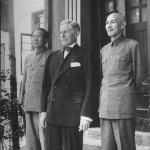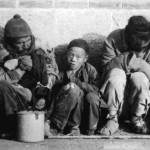
The Chinese Civil War started, in many respects, with the Shanghai Massacre and the collapse of the First United Front in 1927. The main phase of the Chinese Civil War, however, is generally regarded as the period spanning late 1945 to October 1949. After the Japanese surrender in August 1945, the Chinese Communist Party (CCP) and the Nationalists agreed to peace talks and an abortive ceasefire. But by the start of 1946, the two were again fighting for control of China. The Chinese Civil War culminated in the CCP’s capture of Beijing, where its leader Mao Zedong declared the formation of the People’s Republic of China (PRC). Nationalist generalissimo Jiang Jieshi was forced to retreat to Taiwan, where he established an alternative government called the Republic of China (ROC). The civil war inflicted major suffering on China’s civilian population, already exhausted and economically ravaged by decades of revolution, warlordism and conflict with the Japanese. The war caused millions of casualties, collapsed the economy through hyperinflation and corruption, and displaced millions of refugees. The CCP secured victory in 1949 but like the Republicans of 1912, they inherited a divided, unstable and economically depleted nation.
With the Japanese surrender in August 1945, most observers believed the CCP and Nationalists would revive their civil war. In late 1945 foreign intermediaries, particularly the Americans, tried to broker peace talks between the two groups. In late August 1945 Mao Zedong and Zhou Enlai attended peace talks with Jiang Jieshi and other Nationalist leaders in Chongqing. Mao and Zhou attended at the urging of the Soviet Union and were accompanied by US diplomat Patrick Hurley. These talks were notable for their civility and frequent shows of goodwill between Mao and Jiang Jieshi. At one function in Chongqing, Jiang raised a toast and declared that he hoped “we can now go back to the days of 1924”. At another dinner, Mao even exclaimed: “Long live President Jiang Jieshi!”. The two men were also photographed together smiling. But beneath this polite veneer, the Chongqing talks were insincere and unproductive. Both sides were manoeuvring behind the scenes and buying time for their military forces to recover and regroup. The United States was promising to support a coalition government while increasing shipments of military supplies to the Nationalists.

After three weeks of negotiating Mao and Jiang announced a bilateral pact, agreeing to suspend hostilities and form an all-party government. As expected, the pact did not last long. Fighting between the CCP and Nationalists soon flared up again in Manchuria, an area at this time controlled by the Soviet Red Army. As Soviet leader Joseph Stalin played both the CCP and Guomindang to his own advantage, US general George Marshall forced Jiang’s government to agree to a 15 day ceasefire, which gave the beleaguered CCP a lifeline. Jiang had negotiated with Moscow to allow Soviet troops to occupy Manchuria, until he could mass enough troops there to counter any threat from the CCP. The Russians held to this agreement but offered the CCP’s Red Army training, weapons and supplies before withdrawing. This support helped transform communist guerrilla fighters in Manchuria into a more conventional military force. George Marshall continued to push Jiang for further negotiations but was frustrated by the generalissimo’s attitude, so returned to the US in January 1947. American president Harry Truman later noted the “selfish interest of extremist elements, equally in the Guomindang as in the Communist Party, are hindering the aspirations of the Chinese people”.

The Civil War had a significant impact on the Chinese people. The historian Jonathan Fenby suggests that “hyperinflation [during the Chinese Civil War] undermined everyday lives and ruined tens of millions”. Hampered by a poor taxation base, increased military spending and widespread corruption, the Nationalist government’s deficit skyrocketed. The Sino-Japanese War also caused government revenue to shrink, forcing the Guomindang to release large amounts of paper money not backed by financial reserves. The result was hyperinflation: a rapid rise in prices and a deterioration in the value of currency. Historian Michael Lynch writes that “in 1940, 100 yuan bought a pig, in 1943 a chicken, in 1945 a fish, in 1946 an egg, and in 1947 one third of a box of matches”. By 1949 hyperinflation was approaching the levels seen in Weimar Germany in 1923, with some Chinese observed hauling their money in carts. A thriving black market emerged and crime increased. Foreign aid supplies were hijacked and sold, reconstruction of industry was halted and unemployment rose. The behaviour of the Nationalist army only increased dissatisfaction with the government. Nationalists troops, the majority of whom were poorly treated conscripts, mutinied or deserted in large numbers. Soldiers also engaged in rape, looting and other acts of brutality against the civilian population. This unpopularity grew further when Jiang repeated a tactic he had previously used against the Japanese, ordering the diversion of the Yellow River to split enemy forces. The outcome was around 500 villages flooded and 400,000 people displaced.
The CCP, on the other hand, was winning the propaganda war. While Nationalist forces were able to capture the communist soviet in Yan’an in March 1947, the CCP still controlled much of northern China. By September 1947 the civil war was being fought on two fronts: the huge Manchurian theatre in the north and the triangle of Shandong, Anhui and Henan in east-central China. In late 1947 the communists captured the cities of Shenyang and Changchun. The Red Army laid siege to Changchun for 150 days, a tactic designed to starve out GMD forces inside the city – but the siege caused 160,000 civilians to die of hunger, while another 30,000 died when they were trapped between the communist lines and the city walls. In his book The Tragedy of Liberation, historian Frank Dikötter describes the casual attitude of both communists and Nationalists when it came to the civilian loss of life. “After decades of propaganda about the peaceful liberation of China,” Dikötter writes, “few people remember the victims of the Communist Party’s rise to power”. While statistics vary, it has been suggested that up to 2.5 million people died during the 1945-1949 phase of the Civil War. Several historians suggest the death toll for the entire Chinese Civil War period (1927-49) exceeded six million.
“There is a sense in which the Chinese Civil War has not ended; no formal peace treaty or agreement has ever been made. The two Chinese states that emerged from the civil war, the PRC and Taiwan, have followed very different paths… but each side continues to claim that it alone is the legitimate government of all China. At the start of the second decade of the 21st century, the issues over which the civil war had been fought have still to be resolved.”
Michael Lynch, historian
In late 1948, with CCP forces increasing their grip on China and closing in on Beijing, Jiang Jieshi called for the reopening of peace talks. Appealing to the United States and the Soviet Union for mediation, Jiang found little support, while Mao refused his offers. The climax of the war came in early 1949 when the Nationalist general Fu Zuoyi was forced to surrender Beijing. The Red Army was met by cheering crowds as they marched into the city, while at the Gate of Heavenly Peace, Jiang Jieshi’s portrait was replaced by an image of Mao Zedong. One after another cities fell to the CCP. On October 10th 1949, the 55-year-old party leader addressed the nation from Tiananmen Square, declaring that “the Central People’s Government of the People’s Republic of China is founded today”. In the weeks after this momentous declaration, the Red Army chased Jiang across the country, from Guangzhou to Chongqing to Chengdu. Finally, on December 10th 1949, the generalissimo fled by aeroplane to Taiwan, his departure marking the end of the Nationalist era in China.

Jiang Jieshi left China with around 500,000 loyalist soldiers and two million civilian refugees. He was still unwilling to accept defeat. In Taiwan, Jiang established the Republic of China (ROC). He remained president of this republic until his death in April 1975, his rule exceeding a quarter of a century. Jiang’s Taiwanese government was bankrolled by gold, silver and banknotes worth hundreds of millions of US dollars. Much of this was snatched from banks and government coffers as the Nationalists prepared to flee China. Millions of dollars worth of art and artefacts were also confiscated, from buildings like the Imperial Palace, and taken to Taiwan, where they remain today. Jiang maintained his claim as the rightful ruler of China. He declared the ROC to be China’s legitimate government in exile, further widening the political split between the mainland and Taiwan. Many western nations refused to acknowledge the CCP as the rightful rulers of China for decades after 1949. No peace treaty was signed by the CCP and Guomindang, so technically the civil war continues today; it is in hiatus rather than a state of conclusion.

1. The Civil War between the Chinese Communist Party and the Nationalists can be traced back to 1927, however, it usually refers to the struggle for China between the end of World War II and October 1949.
2. The Americans brought Mao Zedong and Jiang Jieshi together for peace talks in Chongqing in 1946 but their commitment to a unified China was short lived and fighting quickly resumed.
3. Life during the Civil War was severely impacted by economic problems including hyperinflation, mass unemployment, inadequate reconstruction of industry and large numbers of refugees.
4. By early 1949 Beijing had fallen to the CCP and as other major cities across China fell, the CCP declared victory by proclaiming of the People’s Republic of China in October 1949. The ‘liberation’ of China, however, resulted in millions of civilian causalities at the hands of both sides.
5. Jiang Jieshi fled to Taiwan and set up the Republic of China, maintaining that he was the legitimate leader of mainland China. His regime was bankrolled with riches taken from the mainland. He remained president of the ROC until his death in April 1975.
© Alpha History 2018. Content on this page may not be republished or distributed without permission. For more information please refer to our Terms of Use.
This page was written by Rebecca Cairns. To reference this page, use the following citation:
R. Cairns, “The Chinese Civil War”, Alpha History, accessed [today’s date], https://alphahistory.com/chineserevolution/chinese-civil-war/.
This website uses pinyin romanisations of Chinese words and names. Please refer to this page for more information.
